Symbol Code: SM000047 Symbol Name: Nyame Biribi Wo Soro (Category: Prayers )
|
 | “God is in the heavens” symbol of hope A reminder that God’s dwelling place is in the heaven, where he can listen to all prayers.
Reference: |
|
Symbol Code: SM000177 Symbol Name: Kalash (Kalasa) (Category: Prayers )
|
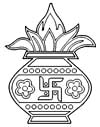 | This symbol, depicting a vase covered with leaves, is a representation of the kalash, a Hindu/Jain ritual implement. The kalash is a clay or copper pot filled with water, and topped with mango leaves and a coconut. The kalash has many symbolic meanings- it is the primordial waters of creation, the soul filled with love and compassion, abundance, and hospitality.
Reference:http://symboldictionary.net/?p=1951 |
|
Symbol Code: SM000178 Symbol Name: Khanda (Sikh Symbol) (Category: Prayers )
|
 | The Khanda is the most recognizable emblem of the Sikh faith, symbolizing the four pillars of Sikh belief. It consists of four symbolic weapons: In the center, the double edged sword, or khanda, from which the symbol derives its name. The Khanda represents knowledge of divinity and the creative power of God. Surrounding the khanda is a circular quoit, called a Chakkar (or chakka), meaning wheel, from the same root as chakra- a medieval weapon which symbolizes the unity of God. On either side, crossed daggers, or kirpans, called Piri and Miri (after the personal weapons of Guru Hargobind), symbolizing spiritual and temporal (earthly) power in balance. Another important device incorporating this symbol is the Nishan Sahib, or Saffron banner, which adorns Sikh Gurudwaras (temples).
Reference:http://symboldictionary.net/?p=1791 |
|
Symbol Code: SM000179 Symbol Name: Vel of Lord Murugan (Category: Prayers )
|
 | This symbolizes the sharp, triangular lance, or Vel, is the sacred weapon of the Hindu war god Murugan (Also called Skanda, Karttikeya, Subramanya). Vel’s other attributes are a peacock and a mace.The vel in Vedic mythology was a demon-slaying instrument; it symbolizes penetrating spiritual knowledge, wisdom, and the cutting away of ignorance. In an annual procession honoring the god in Southern India, it is common for devotees to pierce their cheeks or other body parts with miniature lances.
Reference:http://symboldictionary.net/?p=1831 |
|
Symbol Code: SM000180 Symbol Name: Dharma Wheel (Category: Prayers )
|
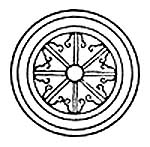 | The dharma chakra (literally, ‘wheel of Law’) Buddhist emblem resembling a wagon wheel, with eight spokes, each representing one of the eight tenets of Buddhist belief. The circle symbolizes the completeness of the Dharma, the spokes represent the eightfold path leading to enlightenment: Right faith, right intention, right speech, right action, right livelihood, right endeavor, right mindfulness, and right meditation.It is drawn from an Indian symbol, but instead of representing Samsara, or endless rebirth, it symbolizes overcoming obstacles. The Dharma wheel is one of the eight Ashtamangala, or auspicious symbols of Tibetan Buddhism. Sometimes, the wheel is flanked by deer, which refer to the deer park in which the Buddha is said to have given his first sermon.
Reference:http://symboldictionary.net/?p=1708 |
|
Symbol Code: SM000181 Symbol Name: Jain Hand (Category: Prayers )
|
 | The emblem of the Jain religion, symbolizing its main tenet, the doctrine of nonviolence. The hand is in the position of the abhaya or “no fear” mudra, a gesture-symbol shared with Hinduism and Buddhism. The wheel in the center of the palm is the wheel of Samsara (or dharmachakra); the word in the center of the wheel reads ahimsa, “stop.”Together, they represent the halting of the cycle of reincarnation through the practice of Jain asceticism, the avoidance of harm to any living creature.
Reference:http://symboldictionary.net/?p=1834 |
|
Symbol Code: SM000887 Symbol Name: Mezuzah (Category: Prayers )
|
 | A mezuzah (Hebrew, doorpost) actually refers to a small case, usually made of metal, which can be found affixed to the doorposts of Jewish homes, schools, and synagogues. Technically, the mezuzah is what is contained in the case, a parchment containing the two Hebrew inscriptions from Deuteronomy required by Jewish religious law to be posted on the doorposts of believers:Hear, O Israel, the Lord is our God, the Lord is one. You shall love the Lord, your God, with all your heart, with all your soul, and with all your resources. And these things that I command you today shall be upon your heart. And you shall teach them to your children, and you shall speak of them when you sit in your house and when you go on the way, when you lie down and when you rise up. And you shall bind them as a sign upon your arm and they shall be an ornament between your eyes. And you shall write them upon the doorposts of your house and on your gates.
Reference:http://symboldictionary.net/?p=2428 |
|
Symbol Code: SM000888 Symbol Name: Bismillah (Basmalah) (Category: Prayers )
|
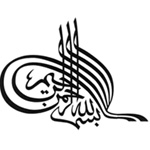 | “Bismillah” in Arabic means, literally, “In the Name of Allah.” This phrase is one of great importance in Islam. It is the opening phrase of the Koran and heads every chapter therein: “Bismillah ir-Rahman ir-Rahim ” In the name of Allah, most Gracious, most Compassionate. “Bismillah” is spoken as a gesture of respect and acknowledgment before undertaking a number of activities, including prayer, eating, and as a general expression of sincerity.The calligraphic examples shown here are just a tiny fraction of the many variants of the written phrase. As images of people and animals are forbidden by Islamic law, designs such as these developed as an alternative form of creative expression, with Islamic artists producing some of the finest examples of the calligraphic art- complex renderings of poetry and scripture in the form of religious symbols, fruits, animals, and birds, to name just a few examples.
Reference:http://symboldictionary.net/?p=2413 |
|
Symbol Code: SM000889 Symbol Name: Orans Gesture (Orant Posture) (Category: Prayers )
|
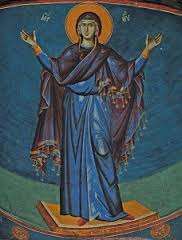 | The orans (latin, prayer) gesture is an ancient mode of prayer common to many ancient religions. It is performed standing, elbows bent or at the side, with arms uplifted and palms upward- a gesture of supplication or pleading.The orans position was widely used in early Christian prayer, but was gradually replaced by the submissive gesture in the laity, although it has been in continual use by priests of the Roman Catholic faith during the celebration of the Mass and other priestly offices. It has been in continual use by both clergy and laity in the Eastern Orthodox Church.The gesture is also gaining new popularity in many charismatic evangelical churches, where it considered more joyful and uplifting.
Reference:http://symboldictionary.net/?p=2271 |
|
Symbol Code: SM000890 Symbol Name: Prayer Wheel (Mani Wheel, Chokor) (Category: Prayers )
|
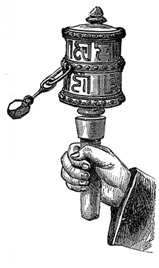 | Tibetan prayer wheels are devices consisting of a spinning cylinder containing copies of the sacred mantra Om Mani Padme Hum (mantra of Chenrezig), written in ancient Tibetan script. It is believed that repeating this mantra accumulates spiritual merit. The prayer wheel functions as an amplifier of sorts, endlessly repeating the mantra as it turns. Small prayer wheels are carried in the hand; a weighted cord aids in turning. Wheels are also hung or placed where they will rotate in the wind or water- some monasteries have enormous stone wheels for the purpose.
Reference:http://symboldictionary.net/?p=1693 |
|
Symbol Code: SM000944 Symbol Name: Praying Mantis (Category: Prayers )
|
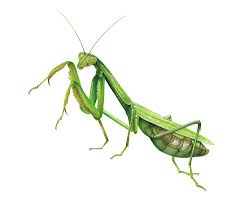 | The mantis comes to us when we need peace, quiet and calm in our lives. Usually the mantis makes an appearance when we've flooded our lives with so much business, activity, or chaos that we can no longer hear the still small voice within us because of the external din we've created.After observing this creature for any length of time you can see why the symbolism of the praying mantis deals with stillness and patience. The mantis takes her time, and lives her life at her own silent pace.
Reference:http://www.whats-your-sign.com/animal-symbolism-mantis.html |
|
Symbol Code: SM000980 Symbol Name: Feather Mandala (Category: PRAYERS )
|
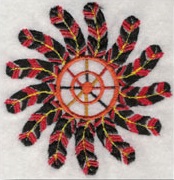 | Feathers represent ascension and spiritual strength. Feathers were worn by Chiefs to symbolize their communication with Spirit, and to express their celestial wisdom. This Native American mandala is representative of the cosmos with the center representing ourselves. When focused upon, we lose ourselves to the finer, lighter energies of the air, and we begin to feel ourselves relax into the knowledge of our presence within the universe. By contemplating such higher ideals, we are able to understand our purposes and desires more clearly.
Reference:http://www.whats-your-sign.com/Native-American-mandala.html |
|
Symbol Code: SM001086 Symbol Name: Wisteria Symbolism (Category: PRAYERS )
|
 | Wisteria blossoms, eloquently falling in tapered clusters, are considered a visual indication of bowing or kneeling down in honor and respect in Feng Shui. Practitioners of Feng Shui are encouraged to plant wisteria in quadrants requiring somber moments of contemplation to instill quiet honor.Shin Buddhism also views the wisteria meaning is as a symbol of prayer, or thoughtful reverence for the same reason. The branches and blossoms seem to lower their head in gentle supplication. These vine gestures naturally bring to mind our need for peace, quiet, and time to honor the divine essence (of our own understanding).
Reference:http://www.whats-your-sign.com/wisteria-meaning.html |
|
Symbol Code: SM001087 Symbol Name: Taranis (Category: PRAYERS )
|
 | Taranis is the unmistakable Celtic god of the heavens, more commonly known as the thunder god. Often thought to come by his boisterous tendencies honestly, Taranis was said to infiltrate the sky with thunderous energy when he became inebriated after drinking too much Celtic mead. As mead was often a constant during celebrations of marriage and battle victories, Taranis was a good-humored god and served as a figure of whole-hearted joy and zeal. As with all Celtic gods and goddesses, Taranis also had a dual nature. When provoked he could bring the fury of the skies down to smote those in need of punishment. Nevertheless, Taranis is generally depicted as a fair god, and slow to wrath. Taranis is commonly seen riding across the heavens in a chariot, his horses very much a part of his power – their galloping hooves would usually produce the crack of thunder and sparks of lightening in the skies.
Reference:http://www.whats-your-sign.com/celtic-gods-and-goddesses.html |
|
Symbol Code: SM001088 Symbol Name: Epona (Category: PRAYERS )
|
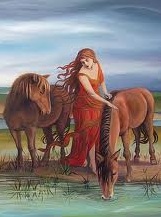 | Mother horse goddess of Earth, Epona was invoked often, but more frequently during the equinoxes to bring about smooth passage of the seasons (both physically and philosophically). Epona is the Celtic goddess called to honor equinox ceremonies; reinforcing her power to deftly deal with transitions. As an Earth goddess, she is hailed for her grounding nature, particularly needed during times of crisis or flux in life. Always depicted upon a horse (another Celtic sign of fertility), Epona would also serve as the guardian of new life. She would welcome safe arrival of new babies as well as new crops.
Reference:http://www.whats-your-sign.com/celtic-gods-and-goddesses.html |
|